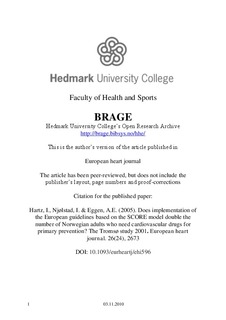| dc.contributor.author | Hartz, Ingeborg | |
| dc.contributor.author | Njølstad, Inger | |
| dc.contributor.author | Eggen, Anne Elise | |
| dc.date.accessioned | 2010-11-03T14:39:47Z | |
| dc.date.available | 2010-11-03T14:39:47Z | |
| dc.date.issued | 2005 | |
| dc.identifier.citation | Hartz, I., Njølstad, I. & Eggen, A.E. (2005). Does implementation of the European guidelines based on the SCORE model double the number of Norwegian adults who need cardiovascular drugs for primary prevention? The Tromsø study 2001. European heart journal. 26(24), 2673 | en_US |
| dc.identifier.issn | 0195-668x | |
| dc.identifier.uri | http://hdl.handle.net/11250/134238 | |
| dc.description | This is a pre-copy-editing, author-produced PDF of an article accepted for publication in European Heart Journal following peer review. The definitive publisher-authenticated version Hartz, I., Njølstad, I. & Eggen, A.E. (2005). Does implementation of the European guidelines based on the SCORE model double the number of Norwegian adults who need cardiovascular drugs for primary prevention? The Tromsø study 2001. European heart journal. 26(24), 2673 is available online at: dx.doi.org/10.1093/eurheartj/ehi556 | en_US |
| dc.description.abstract | Aims To study the implications of European guidelines on the use of antihypertensives and/or lipidlowering
drugs (LLDs) for primary prevention in a Norwegian population.
Methods and results The Tromsø study is a population-based study in the municipality Tromsø, Norway
(from 1974 to till now). This analysis includes 45–79-year-old participants in 2001 (n ¼ 6362, attendance
rate 86%). From the age of 60 years in men and 70 years in women, almost all participants were defined
as high-risk individuals according to the European guidelines, with established cardiovascular disease,
diabetes, or a 10-year risk score of 5%. In the primary prevention subgroup of the 45–64-year-olds,
recommended antihypertensive and/or LLD use would be higher in men only, 42% compared with 12%
on current medication. Among the 65–79-year-olds, .90% would be eligible for antihypertensives
and/or LLDs in both sexes when compared with current treatment rates of ,30%. In total, 40% of all
participants aged 45–79 would be candidates for primary prevention, compared with 15% on current
medication.
Conclusion The implementation of the European guidelines could imply a doubling of the numbers of
Norwegian adults on cardiovascular medication for primary prevention. Contributors to the increase
would be more frequent drug use in men and elderly people, particularly for LLD use. | en_US |
| dc.language.iso | eng | en_US |
| dc.publisher | European Heart Journal | en_US |
| dc.subject | Risk assessment | en_US |
| dc.subject | Antihypertensives | en_US |
| dc.subject | Lipid-lowering drugs | en_US |
| dc.subject | Primary prevention | en_US |
| dc.subject | Cardiovascular disease | en_US |
| dc.title | Does implementation of the European guidelines based on the SCORE model double the number of Norwegian adults who need cardiovascular drugs for primary prevention? The Tromsø study 2001 | en_US |
| dc.type | Journal article | en_US |
| dc.type | Peer reviewed | en_US |
| dc.subject.nsi | VDP::Medical disciplines: 700::Basic medical, dental and veterinary science disciplines: 710::Pharmacognosy: 738 | en_US |
| dc.subject.nsi | VDP::Medical disciplines: 700 | en_US |
| dc.source.pagenumber | 2673–2680 | en_US |
| dc.identifier.doi | http://dx.doi.org/10.1093/eurheartj/ehi596 | |
